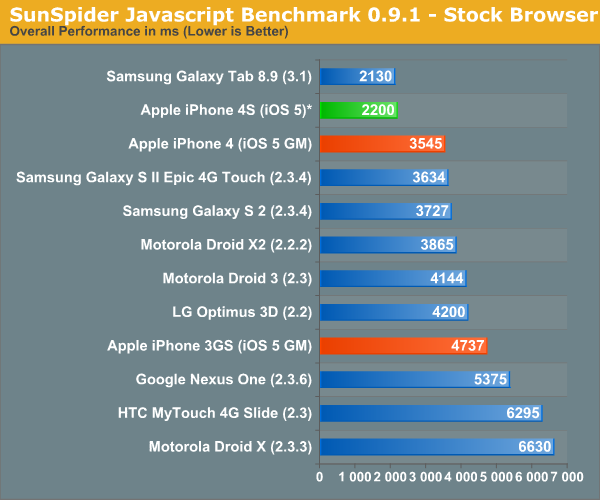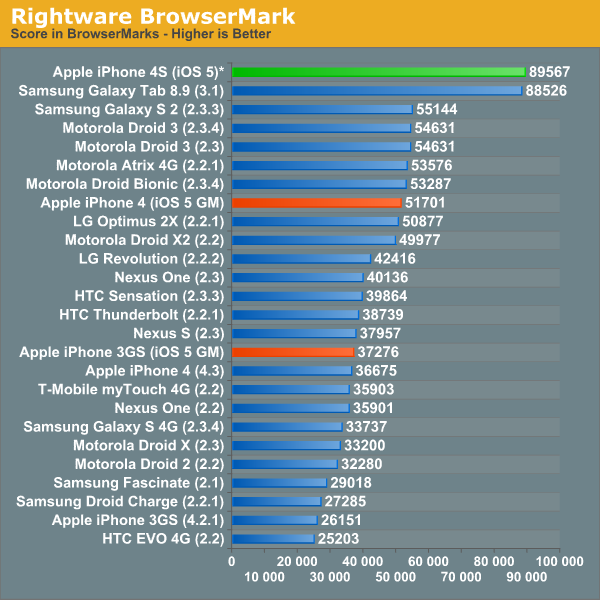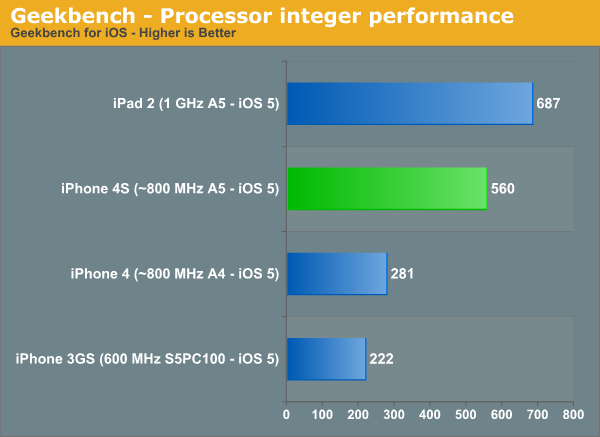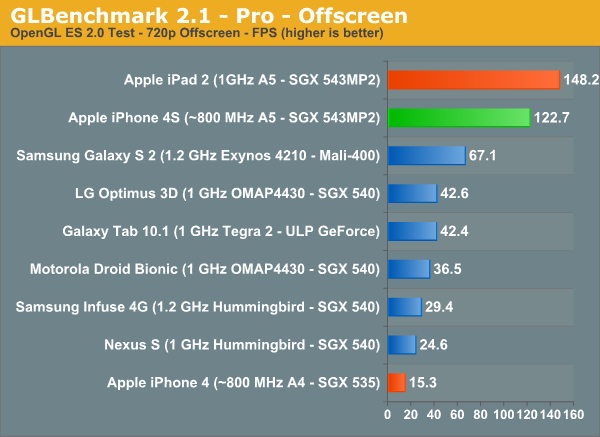iPhone 4S Preliminary Benchmarks: ~800MHz A5, Slightly Slower GPU than iPad 2, Still Very Fast
by Anand Lal Shimpi & Brian Klug on October 11, 2011 3:22 AM EST- Posted in
- Smartphones
- Apple
- Mobile
- iPhone 4S
- SoCs
Apple's ability to control the entire information chain, down to the point of limiting leaks, appears to be gradually slipping as it grows as a company. Case in point are the numerous hardware and performance leaks surrounding the newly launched iPhone 4S. Little did we know that several weeks ago we were staring at photos of the 4S' PCB, and more recently we've seen the first performance results from Apple's first A5 based smartphone thanks to a few eager users around the web. We've compiled these results here from various sources (all linked below) and compared them to our existing database of tests.
The results are pretty much as expected. Javascript performance finally catches up to Tegra 2 based Honeycomb devices, while general CPU performance is significantly higher than the iPhone 4. I suspect Ice Cream Sandwich will bridge the Android smartphone gap (the Honeycomb equipped Gtab 8.9 is here to give you an idea of where a more modern Android browser ends up).
Keep in mind that all of these tests measure performance of the software stack in addition to the hardware. In particular the web browser tests depend largely on browser optimizations, which is why we see differences between similar hardware running different browser versions. Also note that all results were run at stock, with the stock browser. Finally, although these browser tests were captured on video we'll still be running our official tests once our 4Ses arrive and will update accordingly.


Using some of the integer and fp tests of published Geekbench scores we can already conclude that Apple is shipping a lower clocked A5 in the iPhone 4S than it does in the iPad 2. This naturally makes sense as the iPhone 4S has a much smaller 5.25 Whr battery. Based on the Geekbench results it looks like the iPad 2 is clocked around 25% higher than the iPhone 4S, pegging the latter's clock speed at 800MHz.


A lower clock not only means higher yields from the factory, but likely a lower operating voltage as well. Dropping a CPU's core voltage, yields a greater-than-linear decrease in power consumption, making the marginal loss in clock speed a good choice. At a lower operating frequency than its Android competitors, Apple does have to exploit its strengths in software to avoid any tangible performance penalties. Apple has traditionally done this very well in the past, so I don't expect the loss of frequency to be a huge deal to the few who do cross-shop iOS and Android.
Unsurprisingly, memory bandwidth doesn't appear to have gone up either compared to the iPad 2's A5 (taking into account scaling due to CPU clock increases). The Samsung part number on the iPad 2's A5 indicates two LPDDR2-800 die on package, it's safe to assume that whatever Apple clocked the memory interface at in the iPad 2 remains unchanged in the iPhone 4S.
The GPU results tell a similar story courtesy of some early GLBenchmark 2.1 results. The 960 x 640 results are useless as they are bound by vsync at ~60 fps. Luckly GLBenchmark 2.1 added an off-screen render mode at 1280 x 720 where we can really see the differences between the iPad 2 and iPhone 4S A5 implementations:


Here the iPad 2 holds a ~21% performance advantage, which once again I assume to be all related to clock speed. Also note the huge advantage over the existing iPhone 4. The GPU power in the 4S should be more than enough to run any well written, current generation title at well north of 30 fps on its display.
We'll be reviewing the iPhone 4S in the coming weeks, stay tuned!
Source: GLBenchmark Database, Geekbench Database, Macrumors










216 Comments
View All Comments
Brian Klug - Tuesday, October 11, 2011 - link
The results that are starred (*) are those that leaked today and don't have duplicates or confirmation, the other results are run by either myself or Anand (iPhone 4 / 3GS).The results from GLBenchmark 2.1 and Geekbench seem credible (multiple results).
-Brian
wicktron - Tuesday, October 11, 2011 - link
There's a difference between designed by Samsung and manufactured by Samsung.The A5 is designed by Apple and manufactured in Samsung factories.
Exynos is designed and manufactured by Samsung.
vision33r - Tuesday, October 11, 2011 - link
And that's why the Exynos is inferior to the A5. If it was better, Apple would've used it.doubledeej - Tuesday, October 11, 2011 - link
Uhhh... JavaScript performance is as much tied to software implementation as it is CPU. For the sake of argument, if Safari's JavaScript interpreter was twice as fast as Android's, you could run a CPU half as fast and get the same performance. iOS5 improves JavaScript performance quite a bit.doobydoo - Sunday, October 16, 2011 - link
Thank god we're not just comparing javascript performance, then.vision33r - Tuesday, October 11, 2011 - link
It's an Apple designed CPU manufactured by Samsung. Of course the A6 will be designed by Apple and manufactured by TSMC.A4/A5 borrows some Samsung technology from contractual agreement. The A6 will have to design around Samsung's IP in order to get out avoiding lawsuits.
KoolAidMan1 - Wednesday, October 12, 2011 - link
"Is Android that much of a bottleneck?"Given that iOS on A4 or WP7 on Snapdragon was faster than Android on the technically faster and much newer Humminbird, yes, I'd say that Android is a huge bottleneck on performance.
Having all the clockspeed in the world doesn't matter when the OS has fundamental issues holding it back.
humancyborg - Monday, October 17, 2011 - link
The A5 is *NOT* a "Samsung CPU". Samsung is simply the manufacturer.Brian Klug - Tuesday, October 11, 2011 - link
Are you running the stock browser or something else? I wager something else. The results in that table are reflective of an international SGS2 running the latest stock ROM from Kies (XXKI1, which is 2.3.4). I'm not running CM7.1 on this SGS2 presently. I just ran again and got 4647.0ms, so I consider our score above to be representative, if an optimistic outlier, even.This is also the stock/default browser. The Sunspider 0.9 numbers on Android have always been that way for the sake of comparing between SoCs.
-Brian
JasonInofuentes - Tuesday, October 11, 2011 - link
The browser GPU acceleration that Brian mentions in his review is designed to smooth scrolling and zooming, but it doesn't actually accelerate the compute process. That remains a good measure of CPU performance. CM7 is a speed optimized ROM and likely running a much newer version of Gingerbread than what shipped stock on the device, as such it's no surprise your scores are faster.